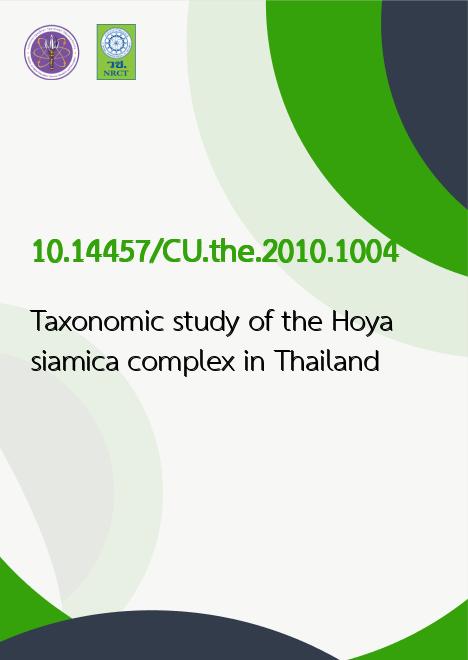
|
Taxonomic study of the Hoya siamica complex in Thailand |
|---|---|
| รหัสดีโอไอ | |
| Title | Taxonomic study of the Hoya siamica complex in Thailand |
| Creator | Duangjai Tungmunnithum |
| Contributor | Manit Kidyoo, Chumpol Khunwasi |
| Publisher | Chulalongkorn University |
| Publication Year | 2553 |
| Keyword | Asclepiadaceae -- Thailand, Hoya -- Thailand, Hoya -- Classification |
| Abstract | Previously, taxonomic status of Hoya siamica complex was still dubious due to extremely variable in morphological characters. The aim of this thesis is to investigate morphological, anatomical, palynological and molecular biological characters of the H. siamica complex in Thailand so as to define its taxonomic status. The variation in shape of leaf, characters of lateral veins, corona and corpusculum provide important criteria for dividing the studied plants into 5 forms i.e. form I-V. These qualitative morphological data showed that form I is obviously different from the others by obscure lateral veins and broadly ovate corpusculum. Form II-V have conspicuous lateral veins, grooved on upper surface and arrow head corpusculum. Form II and III have obovate corona with obtuse outer angle but form IV and V have elliptic-obovate corona with acute outer angle. From II-V are different in leaf shapes. The quantitative characters showed that H. siamica complex in Thailand can be divided into two groups, the first group composed of form I and the second group composed of form II-V. Likewise, the anatomical studies showed that this complex can be classified into 2 groups. The first group (form I) have mesophyll which can be obviously divided into two layers, whereas the second group (form II-IV) cannot be divided. The PCR-RFLP technique was subsequently used to detect diversity of 5 chloroplast DNA regions of this complex which reveals no difference. Therefore, Form I of the H. siamica complex is treated as a variety, due to their great variation in morphological, palynological and anatomical characters as present in this study. In additional, forms II-V of the H. siamica complex as presented in this study indicate that they are variable form of a single species of H. siamica. In all, it is proposed here that H. siamica complex in Thailand composed of H. siamica Craib and a variety. |
| URL Website | cuir.car.chula.ac.th |